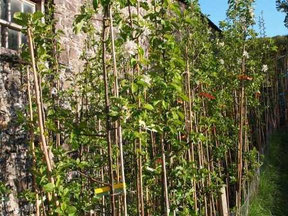About us

My name is James Macduff and together with my partner, Catherine, I’ve started a new apple breeding programme in the Ystwyth Valley in West Wales, under the name ‘Ystwyth Valley Apple Breeders’.
Few, if any, apple breeding programmes remain in the UK, whether small- or large-scale, privately or publicly funded. This is a shame given the long tradition of apple breeding in this country.

Hundreds of varieties were developed during the nineteenth and early twentieth centuries, by a host of breeders, both professional and amateur. Many arose from chance seedlings, others from defined crosses. Some, like Lord Lambourne, Ellison’s Orange and Laxton’s Superb, are truly excellent apples and were of major commercial importance for many decades.
We hope Ystwyth Valley Apple Breeders will contribute to the revival of apple breeding both in Wales and throughout the UK.
Origins

Ystwyth Valley Apple Breeders was conceived in 2009. I'd worked as a research scientist for many years, in soil chemistry and plant nutrition, and more recently in plant breeding, mapping traits associated with nutrient uptake and ecosystem services. But I was keen to do something different, preferably building on my interest in apples. My mother’s family were fruit farmers in the Fens around Wisbech for much of the twentieth century, and I’d always been a keen amateur grower of apples. With this as a starting point, I learnt how to graft and propagate, then how to make crosses between different varieties. We raised a few seedlings from crosses in our garden during 2009. They didn't survive for long, but the seeds of ambition had been sown.

We spent the next few years reading up on the subject and improving our techniques. By 2013 we were ready to start in earnest, albeit on a small scale, aiming to produce around 500 seedlings per annum.
Our approach is outlined below, and explained in more detail in the 'breeding programme' section of this site. It reflects our belief in sustainable production and we hope it provides a blueprint for others interested in taking up apple breeding on whatever scale. Links to scientific and practical aspects of apple breeding are provided in the 'Information' section, together with results from our experimental work with seedling apple trees.
Why do it?

You might ask: Why attempt to breed new varieties when thousands exist already? And why bother when there are plenty of established and successful breeding programmes around the world? These are fair questions, but much the same could be asked of most endeavours. Why design new clothes or write new songs or stories? Surely we have sufficient variants already? Yet people still desire to produce something new, different or better, even if countless wheels are rediscovered along the way. The argument, however, goes much further.
The case for widening the genetic variation in the cultivars and varieties supplying our food is indisputable, not least in the face of the challenges posed by climate change. Breeding for greater resilience in terms of resistance to new and established pests and diseases, and tolerance of environmental perturbations, such as waterlogging and unseasonable temperatures, will become increasingly important. Such concerns don't yet appear to be on the radar of many of the large commercial apple breeding programmes, where performance in production systems under optimal environmental conditions, supported by high inputs of agro-chemicals, is paramount.

Looking beyond the shelves full of Gala and Braeburn, at the newest varieties appearing in the UK’s supermarkets, the genetic base is remarkably narrow. Jazz, Envy and Kanzi, for example, have all been produced from Braeburn x Gala crosses, none of them in the UK. What’s more, the majority of established commercial varieties trace a large proportion of their recent and distant parentage back to just six varieties (Golden Delicious, Cox’s Orange Pippin, Jonathan, McIntosh, Red Delicious and James Grieve).
And the case for sustaining the tradition of apple breeding in the UK? This could be made equally well on strategic, cultural or commercial grounds. Home grown shouldn’t necessarily exclude home-bred.
Our approach
- We are an independent, family-run initiative, unconstrained by commercial sponsors and their requirements.
- We use conventional breeding techniques rather than those based on genetic engineering.
- We use a wide range of parental genotypes, including commercial, heritage and local varieties, plus ‘wild-survivor’ seedlings.
- We do not use Golden Delicious, Cox’s Orange Pippin, Jonathan, McIntosh or Red Delicious as parental genotypes.
- Many of our crosses have almost certainly never been made before.
- We grow our seedlings on their own roots throughout their juvenile phase, rather than grafting the juvenile scions onto commercial rootstocks.
- We evaluate seedling performance under field conditions, exposed to diseases including scab, canker and powdery mildew, and to insect pests including sawfly and codling moth.
- We are sharing the details of our methodology and the results of our studies on seedling populations.
- We are keen to form non-commercial as well as commercial partnerships for variety development and marketing.
- We hope to support diversification in the Welsh Horticultural sector through the development of new ‘Welsh provenance’ varieties.
We have been making selections on the basis of fruit characteristics since 2021.